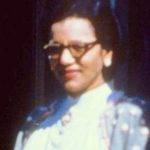Dr. Goonum

Doctor Kesaveloo Goonaruthnum Naidoo (1906 – 1999) The woman who most people knew as Dr Goonam was named Gonarathnam when she was born to R K Naidoo and Thangatchee Naidoo in Durban in 1906. Doctor Kesaveloo Goonaruthnum Naidoo (1906 – 1999) The woman who most people knew as Dr Goonam was named Gonarathnam when she was born to R K Naidoo and Thangatchee Naidoo in Durban in 1906. Gonarathnam grew up in Grey Street, Durban, with her three brothers and three sisters.
The siblings attended the Tamil school Sathia Gnama Sabbai from 7am to 8am before going to English school.
At the age of eleven Gonarathnam become a pupil teacher and brought home her first salary of 10 shillings. Like any child her age the little girl had all kinds of plans for the money, but her mother thought differently.
Gonarathnam’s parents were warm and hospitable, and she got the opportunity to meet some of the renowned Indian activists of the time including Mahatma Gandhi, ML Sultan and Annie Besant. Like the world around her Gonarathnam ‘s teenage years were a time of turmoil as she tried to figure her own destiny.
Then in the summer of 1926 while sitting in her room on the family farm, Gonarathnam finally realised that unlike her sisters she wanted to be educated; that being a housewife was not enough for her. Gonarathnam ‘s mother, who did not get to fulfill her own dream of an education, was pleased with her daughter’s decision.
No medical schools in South Africa would admit an Indian girl at the time and so Gonarathnam was forced to study abroad. Her father was against it because, as Gonarathnam put it, “he was inoculated against educating girls from his cronies”. But she wanted to be a doctor and a doctor she would become. On 8 March 1928, Gonarathnam set out for Scotland. She qualified and returned to South Africa in 1936 and set up her practice in the Grey Street complex.
Gonarathnam became known as ‘Dr Goonam‘ when she graduated from Medical school in Scotland in March 1928.
Her medical work took her to India, Britain, Australia and Zimbabwe, but it’s her political activity that Goonam is best remembered for. She was one of the doctors with Yusuf Dadoo and Monty Naicker who was part of the Natal Indian Congress and led the 1946 Indian Passive Resistance Campaign against the anti-Indian Land Act, which would forcibly remove Indians from their homes and place them in ghettos. The resistance campaign not only fought for Indian rights but it also helped Indian women become more liberal. Dr Goonam was imprisoned many times for her political beliefs.
As a member of the Natal Indian Congress, she was elected vice-president and later Acting President. Constant harassment from the Security Branch in 1977 forced Dr Goonam to leave South Africa for England and she lived in exile thereafter. She returned to South Africa in 1990 and was a proud voter in the first democratic election in 1994.
In 2016 The Sastri Alumni Association held a memorable commemoration of the 1946 Passive Resistance Campaign at the Resistance Park in Durban. A tree was planted in honour of Dr. Goonum who led the second wave of resistance and crossed the border of Natal illegally.
Source: http://www.durban.gov.za/durban/discover/history/famous/politics/goonam
Selected Work
From Coolie Doctor (1991):
“During the first three years of my practice, I was busy but suffered tremendous disadvantages being Black……I applied to the black hospital, King Edward VIII for a post. I thought my chances were good since I was working at the Clearing Station relieving the hospital. Young white doctors recently out of medical school were being appointed to work in the black hospitals, as well as being taken on as Interns at the white hospitals, My application was turned down. The official reply explained “the policy of the country is that non-European doctors could not be admitted to Government hospitals as white nurses would not be prepared to take orders from black doctors!”
Bibliography
1991. Coolie Doctor. Durban: Madiba Publishers.